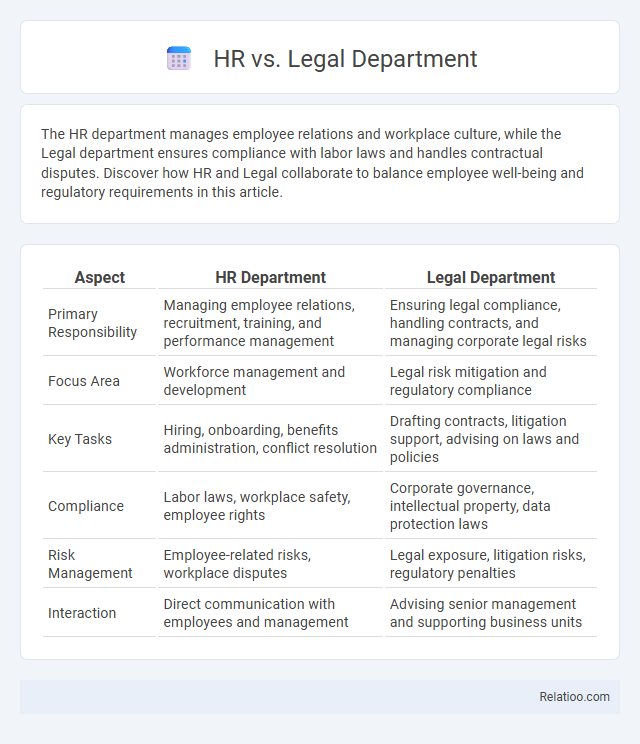The HR department manages employee relations and workplace culture, while the Legal department ensures compliance with labor laws and handles contractual disputes. Discover how HR and Legal collaborate to balance employee well-being and regulatory requirements in this article.
Table of Comparison
| Aspect | HR Department | Legal Department |
|---|---|---|
| Primary Responsibility | Managing employee relations, recruitment, training, and performance management | Ensuring legal compliance, handling contracts, and managing corporate legal risks |
| Focus Area | Workforce management and development | Legal risk mitigation and regulatory compliance |
| Key Tasks | Hiring, onboarding, benefits administration, conflict resolution | Drafting contracts, litigation support, advising on laws and policies |
| Compliance | Labor laws, workplace safety, employee rights | Corporate governance, intellectual property, data protection laws |
| Risk Management | Employee-related risks, workplace disputes | Legal exposure, litigation risks, regulatory penalties |
| Interaction | Direct communication with employees and management | Advising senior management and supporting business units |
Introduction: Understanding the Roles of HR and Legal Departments
The Human Resources (HR) department manages employee relations, recruitment, and workplace policies, ensuring a positive organizational culture and compliance with labor laws. The Legal department handles legal risks, contracts, and regulatory compliance, providing expert guidance on employment laws and dispute resolution. In cases of workplace harassment, HR investigates and addresses complaints while the Legal team ensures adherence to legal standards and mitigates potential liabilities.
Core Functions: HR Department Overview
The HR department primarily manages employee relations, recruitment, benefits administration, and compliance with labor laws, ensuring a productive and legally compliant workplace environment. Legal departments focus on interpreting laws, managing corporate governance, and mitigating legal risks, often advising on employment contracts and disputes. Harassment issues typically involve collaboration between HR and legal teams; HR handles internal investigations and employee support, while legal evaluates liability and regulatory compliance to prevent litigation.
Core Functions: Legal Department Overview
The Legal Department primarily focuses on ensuring organizational compliance with laws and regulations, drafting and reviewing contracts, and managing litigation risks. It provides legal advice on employment policies, including harassment cases, to protect the company from potential lawsuits. Legal professionals collaborate with HR to implement preventive measures and handle investigations while safeguarding legal interests.
Key Differences Between HR and Legal Departments
The HR department focuses on employee relations, recruitment, and workplace policies, while the Legal department handles compliance, risk management, and corporate governance. In cases of harassment, HR manages reporting, investigations, and support, whereas Legal provides advice on legal implications and ensures adherence to labor laws. Understanding their distinct roles helps organizations balance employee well-being with legal liability protection.
Collaboration Points: When HR and Legal Work Together
HR and Legal departments collaborate to ensure workplace policies comply with employment laws and regulations, reducing the risk of harassment claims. Joint efforts in conducting thorough investigations and handling sensitive harassment cases protect employee rights while mitigating organizational liability. Coordinated training programs and clear communication channels enhance prevention strategies and foster a respectful workplace culture.
Compliance Management: HR vs Legal Responsibilities
HR focuses on implementing compliance management by establishing workplace policies, conducting employee training, and monitoring adherence to anti-harassment regulations to maintain a safe environment. The Legal Department handles the interpretation of laws, provides legal guidance on complex compliance issues, and manages risk by advising on regulatory updates and potential litigation. Your organization's effective compliance management requires collaboration between HR's operational role and Legal's advisory capacity to prevent harassment and ensure adherence to employment laws.
Handling Employee Issues: HR vs Legal Perspectives
HR departments prioritize addressing employee issues through mediation, conflict resolution, and policy enforcement to maintain a positive workplace environment. Legal departments focus on ensuring compliance with labor laws, mitigating litigation risks, and managing formal complaints related to harassment and discrimination. Effective handling of employee issues requires collaboration between HR's proactive support and legal's regulatory oversight to balance employee rights with organizational protections.
Policy Development: HR and Legal Department Input
HR and Legal Departments collaborate closely in policy development to ensure workplace harassment policies are both comprehensive and legally compliant. HR contributes expertise on employee relations and organizational culture, while the Legal Department provides guidance on statutory requirements and risk mitigation. This synergy results in clear, enforceable harassment policies that protect employees and minimize legal liabilities.
Risk Management: Distinct Approaches of HR and Legal
HR focuses on fostering a safe workplace by implementing training programs and reporting mechanisms to proactively address harassment risks. The Legal Department handles compliance with labor laws and regulations, mitigating liability through contract reviews and dispute resolution strategies. Your organization benefits from these distinct approaches by combining HR's preventive measures with Legal's enforcement and risk containment expertise.
Conclusion: Choosing the Right Department for Workplace Challenges
Choosing the right department for workplace challenges depends on the nature of the issue you face. HR specializes in employee relations and conflict resolution, while the Legal Department handles compliance, contracts, and legal disputes. Understanding these roles ensures your concerns are addressed effectively, protecting your rights and fostering a safe work environment.

Infographic: HR vs Legal Department
 relatioo.com
relatioo.com